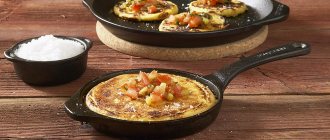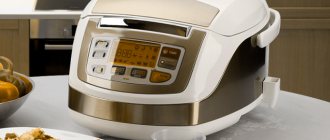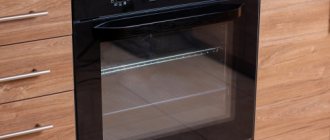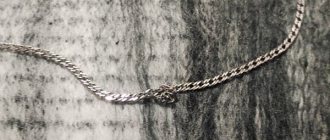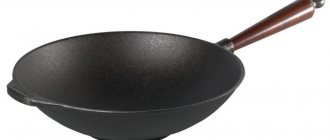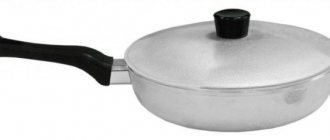Icer Figured out how to restore dishes
When out of three frying pans in our kitchen, only one was left in good condition, I decided to figure out whether it was possible to restore the dishes. I read expert advice on what to do to prevent it from sticking to the pan, and studied the manufacturers' recommendations. I'll tell you how to give a second life to products.
If you wash a non-stick product or a cast iron frying pan with a metal sponge, don’t be surprised that food sticks to the surface
What to do if food still sticks
Sometimes, due to circumstances, food burns and it seems that nothing can help the frying pan. There is no need to try to scrape - there are other ways to clean it.
Heating with detergent
This method is safe for any type of cookware. Apart from stainless steel, you cannot use steel wool - it will severely scratch the surface.
What to do:
- pour water - it should completely cover the bottom (take into account evaporation during boiling);
- add liquid (a few drops) or powdered (1-2 tbsp) dish soap;
- bring to a boil and simmer over medium heat for 10-15 minutes;
- cool, drain the dirty water and remove the softened dirt with a wooden or silicone spatula;
- clean with a sponge, using soap, liquid detergent, baking soda, coarse salt.
Cleaning with vinegar and soda
The method is suitable for cleaning cast iron, stainless steel, and any coating, but it is not recommended for use with aluminum.
Procedure:
- fill the pan with water;
- pour in table vinegar, ratio 1:1;
- Bring to a boil over medium heat, simmer for 10-15 minutes;
- remove from heat, add 2 tbsp. l. baking soda;
- after the reaction stops (bubbles stop forming and there is no hissing), drain the cooled water;
- remove dirt with a wooden spatula, wash with a sponge and soap and dish soap.
If some area cannot be cleaned, then pour soda on it and drop a little water - you will get a paste with which the dirt should be removed. If necessary, repeat the procedure several times.
Important safety rules during calcination
Preparing an aluminum frying pan for the first use is easy. Meanwhile, you should pay close attention to safety measures during this activity:
- Never pour water into hot oil.
- After heating, do not immediately wash the hot pan with water.
- Prepare thick oven mitts in advance so as not to burn your hands, and a stand so as not to damage the table.
- Make sure there are no flammable materials nearby.
Cast iron and stainless steel
These materials are also popular in making tableware. But they also require careful care. In order not to spoil the dishes, you need to follow simple rules:
- You need to cook on a clean surface.
- Cold foods should not be used; they should be at room temperature.
- It is prohibited to fry wet foods. If there is water on the food, it will lower the temperature of the hot oil, causing it to burn. Before cooking, the food should be blotted with a paper towel.
- Don't wait for the oil to heat up. You can add cold oil to a hot frying pan.
- It is not advisable to use many products.
Every housewife knows the phenomenon that a cast iron frying pan burns. What to do in this case? You must use one of the proven methods.
Service life of pans
| Material from which the frying pan is made | Life time |
| Cast iron | Decades |
| Stainless steel | Up to 6-10 years |
| Ceramics | From 3 to 5 years |
| Aluminum | From 3 to 8-10 years |
| Non-stick coating | From 3 to 10 years (depending on texture) |
| Enameled | Becomes unusable after any damage |
How to prevent anything from sticking to the pan
Before buying a frying pan, you need to decide on the purpose of purchasing it, in order to use it for its intended purpose and not suffer from the problem of burning. For all types of frying, it is recommended to choose pans with a non-stick coating; for stewing, uncoated pans are suitable. Operation begins with preparation. What and how to do depends on the type of metal and the properties of the coating.
What to do to prevent a stainless steel pan from sticking
Stainless steel cookware is durable, easy to use, resistant to brushes and metal spatulas, and you have to try hard for it to start burning. In any case, this happens when used incorrectly.
If this does happen, then you first need to clean it well, rinse it literally to its original shine and calcinate it. How to do it:
- soak in soapy water for 30-60 minutes;
- remove dirt, clean using various means;
- pour water with table vinegar (1:3), heat to a boil and boil for 15 minutes;
- drain the liquid, cool, rinse with clean water, wipe dry;
- Before use, heat with peanut butter for 5 minutes.
In the future, do not neglect the rules that will help avoid sticking:
- the heating should be such that the water droplets bounce;
- Pour in the oil at the very beginning of cooking and heat it gradually.
A quality steel frying pan should have a chromium to nickel ratio of 18/10. This characteristic is indicated in the product passport.
Aluminum coated frying pan burns
If you start using an aluminum frying pan without treating it after purchase, then burning is guaranteed, since the surface is porous and microparticles of food react with metal molecules when heated. To prevent this from happening, you need to do the following:
- wash new dishes with soap, rinse, wipe dry;
- pour unrefined vegetable oil (the bottom should be closed), grease the walls, add 2-3 tbsp. l. salt, stir;
- heat over low heat until smoking appears;
- cool, rinse without using any products, dry.
The method can also be used when food begins to stick. If scratches form, you can use another method: soak pieces of fresh bread in a dry frying pan until golden brown, then cool and wipe with a paper napkin.
Food sticks to ceramic frying pan
Of all types of coating, ceramic is the most short-lived - with daily use, after about six months, food begins to stick. The quality of the coating decreases if such a frying pan is washed in the dishwasher, or if abrasives or hard brushes are used.
You can try to revive it for a while in a simple way using vegetable oil: generously lubricate the inner surface, leave for a quarter of an hour, wipe with a paper napkin. In the future, the method is repeated after 12-15 uses. If the method does not help, then you will have to simmer rather than fry in a frying pan. If the layer is severely damaged, it is better not to use the dishes.
The cast iron frying pan began to burn
Even your tried-and-true favorite cast iron frying pan can throw up surprises if you don't wash it properly, so proper care is important in maintaining its quality.
The proposed method for restoring properties is also suitable for new dishes:
- wash with detergent, wipe, dry;
- distribute the salt evenly so that it covers the bottom (layer 1.5-2 cm);
- heat on fire for 3-7 minutes;
- cool, remove salt, wipe (literally rub) the surface with vegetable oil;
- leave for some time, remove the oil with a napkin (no need to wash).
Oddly enough, a simple and original method is effective: dry pieces of fresh bread without oil over low heat. The surface will then stop sticking.
Surface cleaning
If a cast iron frying pan burns, what should you do? This material is considered reliable and durable. The porous material retains heat, so it is possible to simmer dishes slowly. The following methods are used for cleansing:
- The dishes need to be boiled with soda. The frying pan may not work well due to carbon deposits. To remove it, water is poured into the container, after which soda is poured. Everything needs to be boiled for a few minutes and washed.
- Heat the container with salt. It is poured in a layer of 1 cm, and the frying pan must be put on fire. You need to wait half an hour, turn off the heat, wait for it to cool. Then you need to remove the salt with a napkin. The effect can be improved with linseed or sunflower oil, which is poured into a container.
- You can just fry the bread. There is no need to add oil. The product absorbs all the burnt residue.
Enameled Dutch oven
The enamel coating is quite strong, but requires delicate handling. Enameled frying pans look very beautiful, but it is strictly forbidden to heat them. This method will completely damage the coating. If food begins to stick to the bottom, you can do the following:
- Clean the pan thoroughly using a soft sponge and detergent.
- Dry the utensils with a paper towel.
- Generously coat the entire inner surface with fat or lard.
To prevent food from sticking to the enamel frying pan, you should carry out the above procedure before each cooking. At the same time, using oil will avoid burning.
Caring for frying pans
Tips for caring for a frying pan depending on the material from which it is made.
Teflon coated
It does not require special care. Thanks to Teflon, it independently prevents the formation of soot both inside and outside. If it does appear, then you need to fill the frying pan with hot water for half an hour. For greater effect, you can add a drop of detergent or add 3 tbsp. spoons of baking soda. The carbon deposits will dissolve without the use of prohibited abrasives. Wipe it with a soft sponge.
It is important to remember that the Teflon coating is easily damaged.
Stainless steel
Steel is the most finicky metal from which cookware is made. A minor defect is immediately visible, and food easily burns to the surface.
Frying pan with ceramic coating: pros and cons, how to choose
You can clean carbon deposits from stainless steel using table salt, soda or vinegar with citric acid.
Cast iron
They are practically eternal, unpretentious and harmless. Cast iron frying pans can be called eternal. They are absolutely easy to care for and do not release harmful substances into food. In addition, they do not lose their appearance even over the years. All you have to do is clean off the carbon deposits in a timely manner. There are several recipes for the best ways to get rid of it.
For cast iron frying pans, care recipes intended for steel ones are suitable. You can also use both baking soda and citric acid vinegar. In addition, cast iron is not afraid of contact with abrasives, so you can safely clean them with brushes and metal sponges.
Ceramic
They are becoming more and more popular. Its surface is smooth and uniform. They are one of the easiest to care for. Any scratch can make the frying pan unusable, so you need to purchase special products for ceramics to dissolve carbon deposits.
Aluminum utensils
Many inconveniences arise during cooking if a frying pan burns. What to do if the utensils are aluminum? The material is quite capricious, but dishes made from it are light, durable and look aesthetically pleasing. To revive it, you can take a number of measures:
- Wash the dishes and dry with a paper towel.
- Heat a dry frying pan over low heat.
- Place small cubes of fresh bread on the bottom.
- Fry the crackers for about 5 minutes.
According to experienced housewives, this unusual method helps reduce sticking to the aluminum bottom of the frying pan.
Reasons why food burns on dishes
As a rule, a frying pan burns for a reason. Certain conditions must be created. This often happens due to:
- purchasing a low-quality frying pan. Companies that respect their reputation produce dishes that last at least 2-3 years. A second-rate fake deteriorates in the first year of use;
- mechanical damage. This is due to the use of metal knives, spatulas, forks for stirring and sponges for cleaning, and storing pans one inside the other;
- expiration date. Consider quality and material when calculating service life;
- sudden temperature changes. Do not move the pan from a hot stove to the refrigerator and vice versa;
- the use of abrasive cleaning agents that disrupt the structure of the surface on which they are applied;
- increased porosity of metal (aluminum, cast iron and enamel).
